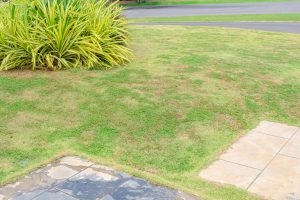Solving the Mystery: Why Is My Grass Dying in Patches?

Discovering patches of dying grass in your lawn can be a disheartening experience for any homeowner. These unsightly brown spots can mar the beauty of your yard and leave you puzzled about their cause. However, with some detective work and the right approach, you can identify the reasons behind these dying patches and learn how to restore your lawn’s health. Learn more about the common causes of lawn damage, if dead spots can grow back, and discover our step-by-step instructions on repairing these areas.
Our lawn care professionals are also at your service to bring expert lawn care services to your yard.
Patches of Grass Dying
Several factors can lead to dying patches in your lawn. Fungal diseases like brown patch disease are common culprits, especially in humid conditions. Excessive thatch, compacted soil, and damage from pet urine can also cause brown patches. Each of these issues can restrict air and nutrient flow to grass roots, resulting in dead spots.
Close inspection can often reveal the cause of the problem. Fungal diseases, for example, may leave a distinct pattern or type of damage on grass blades. Compacted soil will feel hard to the touch, and areas frequented by pets might have a higher concentration of dead patches.
Will Dead Spots in Grass Grow Back?
Grass has a remarkable ability to recover, but the likelihood of dead spots growing back on their own depends on the extent of the damage and the health of the surrounding lawn. In cases where the roots are severely damaged, or the soil conditions are poor, natural regrowth may be limited. Most dead spots require some intervention to fully recover. This can range from simple solutions like adjusting your watering schedule to more involved treatments like reseeding or applying fungicides.
How to Revive Your Lawn
- Start by removing the dead grass from the affected areas. This allows you to assess the soil underneath and prepare for treatment.
- If soil compaction is to blame, aerating your lawn is crucial. Use a lawn aerator to create small holes in the soil, improving air and water flow to the roots.
- If excessive thatch is an issue, dethatching may be necessary. A thatch rake can help remove the layer of dead plant material, allowing water and nutrients to reach the soil more effectively.
- Applying a fungicide can help with brown patches caused by fungal diseases. Be sure to choose a product specifically designed for the type of fungus affecting your lawn.
- Adjust watering practices, as overwatering or underwatering can contribute to dead spots. Water your lawn deeply but infrequently to promote strong root growth.
- After addressing any underlying issues, reseeding the area with an appropriate grass seed is often the next step. Choose a seed that matches your existing lawn and is suitable for your climate.
- To prevent future dead spots, consider practices like regular lawn maintenance, avoiding walking on wet grass, and using pet-friendly lawn care methods.
Call Our Lawn Care Professionals
Dying patches in your lawn can be frustrating, but with the right approach, they can be remedied and prevented in the future. By understanding the common causes of these dead spots, taking steps to repair them, and implementing preventive measures, you can maintain a vibrant and healthy lawn.
For those who prefer an expert touch or are dealing with persistent lawn issues, our lawn care professionals are here to help. From diagnosing the cause of dead patches to implementing tailored solutions, we offer comprehensive services to restore your lawn to its former glory. Contact us to learn more about our lawn care solutions and how we can help you achieve a lush, healthy lawn.


